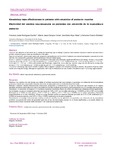Efectividad del vendaje neuromuscular en pacientes con retracción de la musculatura posterior

Ver/
Use este enlace para citar
http://hdl.handle.net/2183/26857
A non ser que se indique outra cousa, a licenza do ítem descríbese como Atribución-NoComercial-CompartirIgual 4.0 España
Coleccións
Metadatos
Mostrar o rexistro completo do ítemTítulo
Efectividad del vendaje neuromuscular en pacientes con retracción de la musculatura posteriorTítulo(s) alternativo(s)
Kinesiology Tape Effectiveness in Patients with Retraction of Posterior MusclesAutor(es)
Data
2020Cita bibliográfica
Rodríguez Castillo, F. J., Campos-Torres, A. J., Rayo-Pérez, A. M., & Chacón-Giráldez, F. (2020). Efectividad del vendaje neuromuscular en pacientes con retracción de la musculatura posterior. European Journal of Podiatry / Revista Europea De Podología, 6(1), 12-18. https://doi.org/10.17979/ejpod.2020.6.1.6540
Resumo
[Resumen] Objetivos: los objetivos de este trabajo son validar el vendaje neuromuscular como terapia en pacientes con retracción de la musculatura posterior y valorar tano una posible variación del centro de gravedad como en la flexión dorsal de tobillo.
Material y métodos: estudio observacional, transversal, prospectivo y multicéntrico en el que se seleccionó una muestra de 21 sujetos atendidos de forma consecutiva a los que se les realizó un estudio mediante goniometría y baropodometría con y sin vendaje neuromuscular.
Resultados: 21 pacientes (8 mujeres y 13 hombres) muestran una flexión dorsal de tobillo con diferencias estadísticamente significativas tras la terapia, ya que se consiguió aumentar una media de 3,09 ± 2.23° con la rodilla extendida (p = 0.00005) y 2.24 ± 2.59° con la rodilla flexionada (p = 0,001) en una pierna y 2.91 ± 3.25° (p = 0.002) y 2.71 ± 2.81° (p = 0.0005) con la rodilla extendida y flexionada respectivamente en la otra. Asimismo, el test de Lunge también mostró un aumento articular promedio de 2.76 ± 2.84 centímetros (p = 0.0005) en la pierna derecha y de 2.67 ± 3.18 (p = 0.003) centímetros en la pierna izquierda.
Conclusiones: el vendaje neuromuscular muestra evidencia científica en su aplicación en pacientes con retracción de la musculatura posterior. La posición del centro de gravedad varía tras el uso de esta terapia, aunque no de forma significativa, y se puede obtener un aumento de la flexión dorsal de tobillo de hasta 3° de media aproximadamente. [Abstract] Objective: the objectives of this article are to validate the kinesiology tape as therapy in patients with retraction of posterior muscles and asses both a possible variation of gravity centre and dorsiflexion of the ankle. Material and methods: observational. transversal. prospective and multicentre trial in which 21 subjects were selected and attended consecutively in this trial who were measured by goniometer and baropodometry with and without taping. Results: 21 patients (8 women and 13 men) show a dorsiflexion of the ankle with statistically significant differences after therapy. because it was possible to increase an average of 3.09 ± 2.23° with extended knee (p = 0.00005) and 2.24 ± 2.59° with flexed knee (p = 0.001) in one leg. and 2.91 ± 3.25° (p = 0.002) and 2.71 ± 2.81° (p = 0.0005) with extended and flexed knee. respectively. in the other leg. Anyway. Lunge test also showed an average joint increase of 2.76 ± 2.84 centimetres (p = 0.0005) at right leg and 2.67 ± 3.18 centimetres (p = 0.003) at left leg. Conclusions: kinesiology tape shows scientific evidence when is applied to patients with retraction of posterior muscles. The position of gravity centre oscilate after using this therapy. although not significantly. and it may be obtained an increase of ankle’s dorsiflexion until 3º on average approximately.
Palabras chave
Vendaje neuromuscular
Goniometría articular
Musculatura gemelar
Athletic tape
Articular arthrometry
Gastrocnemius muscle
Goniometría articular
Musculatura gemelar
Athletic tape
Articular arthrometry
Gastrocnemius muscle
Versión do editor
Dereitos
Atribución-NoComercial-CompartirIgual 4.0 España
ISSN
2445-1835






